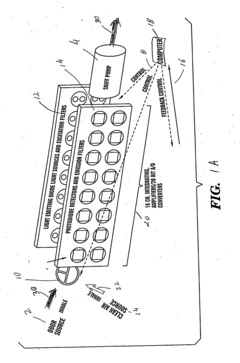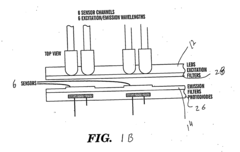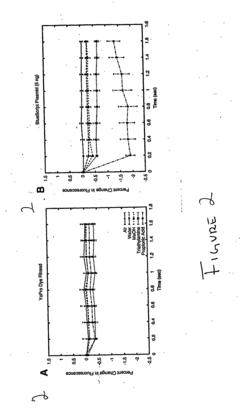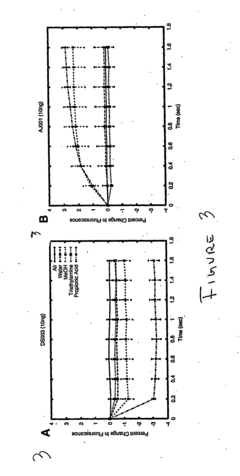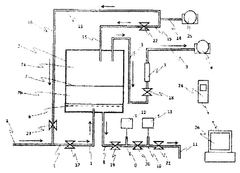Application of Sulphanilic Acid in Air Quality Monitoring Devices
JUL 21, 20259 MIN READ
Generate Your Research Report Instantly with AI Agent
Patsnap Eureka helps you evaluate technical feasibility & market potential.
Sulphanilic Acid in Air Quality Monitoring: Background and Objectives
Sulphanilic acid has emerged as a crucial component in the development and application of air quality monitoring devices. This organic compound, with its unique chemical properties, has become instrumental in detecting and measuring various air pollutants, particularly nitrogen dioxide (NO2) and sulfur dioxide (SO2). The evolution of air quality monitoring technologies has been driven by the growing awareness of the detrimental effects of air pollution on human health and the environment.
The primary objective of incorporating sulphanilic acid in air quality monitoring devices is to enhance the accuracy, sensitivity, and reliability of pollutant detection. This compound serves as a key reagent in colorimetric methods, which are widely used for real-time air quality assessment. The reaction between sulphanilic acid and specific air pollutants produces colored compounds that can be measured spectrophotometrically, allowing for precise quantification of pollutant concentrations.
The development of sulphanilic acid-based air quality monitoring techniques can be traced back to the mid-20th century, with significant advancements occurring in recent decades. These improvements have been driven by the need for more efficient and cost-effective monitoring solutions, as well as the increasing stringency of air quality regulations worldwide. The integration of sulphanilic acid into portable and automated monitoring systems has revolutionized the field, enabling widespread deployment of air quality sensors in urban and industrial environments.
As air pollution continues to be a global concern, the role of sulphanilic acid in air quality monitoring is expected to expand further. Current research focuses on optimizing the sensitivity and selectivity of sulphanilic acid-based detection methods, as well as exploring novel applications in emerging pollutant monitoring. The development of miniaturized sensors and the integration of these devices with Internet of Things (IoT) technologies are also key areas of interest, aiming to create comprehensive air quality monitoring networks.
The ultimate goal of utilizing sulphanilic acid in air quality monitoring devices is to provide accurate, real-time data on air pollutant levels, thereby enabling informed decision-making in environmental management and public health protection. As technology advances, the integration of sulphanilic acid-based sensors with artificial intelligence and big data analytics is expected to yield more sophisticated predictive models for air quality trends and pollution control strategies.
The primary objective of incorporating sulphanilic acid in air quality monitoring devices is to enhance the accuracy, sensitivity, and reliability of pollutant detection. This compound serves as a key reagent in colorimetric methods, which are widely used for real-time air quality assessment. The reaction between sulphanilic acid and specific air pollutants produces colored compounds that can be measured spectrophotometrically, allowing for precise quantification of pollutant concentrations.
The development of sulphanilic acid-based air quality monitoring techniques can be traced back to the mid-20th century, with significant advancements occurring in recent decades. These improvements have been driven by the need for more efficient and cost-effective monitoring solutions, as well as the increasing stringency of air quality regulations worldwide. The integration of sulphanilic acid into portable and automated monitoring systems has revolutionized the field, enabling widespread deployment of air quality sensors in urban and industrial environments.
As air pollution continues to be a global concern, the role of sulphanilic acid in air quality monitoring is expected to expand further. Current research focuses on optimizing the sensitivity and selectivity of sulphanilic acid-based detection methods, as well as exploring novel applications in emerging pollutant monitoring. The development of miniaturized sensors and the integration of these devices with Internet of Things (IoT) technologies are also key areas of interest, aiming to create comprehensive air quality monitoring networks.
The ultimate goal of utilizing sulphanilic acid in air quality monitoring devices is to provide accurate, real-time data on air pollutant levels, thereby enabling informed decision-making in environmental management and public health protection. As technology advances, the integration of sulphanilic acid-based sensors with artificial intelligence and big data analytics is expected to yield more sophisticated predictive models for air quality trends and pollution control strategies.
Market Analysis for Air Quality Monitoring Devices
The global air quality monitoring devices market has been experiencing significant growth in recent years, driven by increasing awareness of air pollution's health impacts and stringent environmental regulations. The market size was valued at approximately $4.2 billion in 2020 and is projected to reach $6.5 billion by 2026, growing at a CAGR of 7.8% during the forecast period.
The demand for air quality monitoring devices is primarily fueled by urbanization, industrialization, and the rising prevalence of respiratory diseases. Governments worldwide are implementing stricter air quality standards, compelling industries and municipalities to invest in advanced monitoring technologies. This regulatory push has created a favorable environment for market expansion.
Sulphanilic acid, a key component in many air quality monitoring devices, plays a crucial role in the detection and measurement of various air pollutants, particularly nitrogen dioxide (NO2). The increasing adoption of sulphanilic acid-based sensors in both fixed and portable air quality monitoring devices has contributed to market growth.
The market is segmented based on product type, pollutant type, end-user, and region. Fixed monitors dominate the product type segment, accounting for the largest market share due to their widespread use in industrial and urban settings. Portable monitors are gaining traction, driven by the growing demand for personal air quality monitoring solutions.
In terms of pollutant types, particulate matter (PM) monitors hold the largest market share, followed by chemical pollutant monitors. The application of sulphanilic acid is particularly relevant in chemical pollutant monitoring, especially for nitrogen oxides (NOx) detection.
Geographically, North America and Europe are the leading markets for air quality monitoring devices, owing to stringent regulations and high environmental awareness. However, the Asia-Pacific region is expected to witness the highest growth rate during the forecast period, driven by rapid industrialization, increasing urbanization, and growing government initiatives to combat air pollution.
Key players in the air quality monitoring devices market include Thermo Fisher Scientific, Emerson Electric, General Electric, Siemens AG, and Teledyne Technologies. These companies are focusing on product innovation, strategic partnerships, and mergers and acquisitions to maintain their market position and expand their product portfolios.
The integration of IoT and AI technologies in air quality monitoring devices is emerging as a significant trend, enabling real-time data collection, analysis, and predictive maintenance. This technological advancement is expected to drive market growth and improve the accuracy and efficiency of air quality monitoring systems.
The demand for air quality monitoring devices is primarily fueled by urbanization, industrialization, and the rising prevalence of respiratory diseases. Governments worldwide are implementing stricter air quality standards, compelling industries and municipalities to invest in advanced monitoring technologies. This regulatory push has created a favorable environment for market expansion.
Sulphanilic acid, a key component in many air quality monitoring devices, plays a crucial role in the detection and measurement of various air pollutants, particularly nitrogen dioxide (NO2). The increasing adoption of sulphanilic acid-based sensors in both fixed and portable air quality monitoring devices has contributed to market growth.
The market is segmented based on product type, pollutant type, end-user, and region. Fixed monitors dominate the product type segment, accounting for the largest market share due to their widespread use in industrial and urban settings. Portable monitors are gaining traction, driven by the growing demand for personal air quality monitoring solutions.
In terms of pollutant types, particulate matter (PM) monitors hold the largest market share, followed by chemical pollutant monitors. The application of sulphanilic acid is particularly relevant in chemical pollutant monitoring, especially for nitrogen oxides (NOx) detection.
Geographically, North America and Europe are the leading markets for air quality monitoring devices, owing to stringent regulations and high environmental awareness. However, the Asia-Pacific region is expected to witness the highest growth rate during the forecast period, driven by rapid industrialization, increasing urbanization, and growing government initiatives to combat air pollution.
Key players in the air quality monitoring devices market include Thermo Fisher Scientific, Emerson Electric, General Electric, Siemens AG, and Teledyne Technologies. These companies are focusing on product innovation, strategic partnerships, and mergers and acquisitions to maintain their market position and expand their product portfolios.
The integration of IoT and AI technologies in air quality monitoring devices is emerging as a significant trend, enabling real-time data collection, analysis, and predictive maintenance. This technological advancement is expected to drive market growth and improve the accuracy and efficiency of air quality monitoring systems.
Current Challenges in Air Pollutant Detection Technologies
Air pollutant detection technologies have made significant strides in recent years, yet several challenges persist in achieving accurate, real-time, and cost-effective monitoring of air quality. One of the primary obstacles is the complexity of air pollution composition, which often includes a diverse mix of particulate matter, gases, and volatile organic compounds. This heterogeneity makes it difficult to develop a single, comprehensive detection method capable of identifying and quantifying all relevant pollutants simultaneously.
The miniaturization of sensing devices, while beneficial for portability and widespread deployment, introduces challenges in maintaining sensitivity and accuracy. Smaller sensors often struggle with cross-sensitivity issues, where they may respond to multiple pollutants, leading to potential misidentification or overestimation of specific contaminants. This problem is particularly acute in urban environments where a complex mixture of pollutants is present.
Another significant challenge lies in the calibration and long-term stability of air quality monitoring devices. Environmental factors such as temperature, humidity, and pressure can significantly affect sensor performance, necessitating frequent recalibration. This requirement increases maintenance costs and can lead to data inconsistencies if not properly managed. Additionally, sensor drift over time can result in gradual loss of accuracy, making it challenging to maintain reliable long-term monitoring networks.
The detection of ultra-low concentrations of certain harmful pollutants remains a technical hurdle. While some pollutants are dangerous even at very low levels, current technologies may lack the sensitivity to detect these trace amounts reliably. This limitation is particularly concerning for emerging contaminants or those with newly recognized health impacts, where regulatory standards may require detection at increasingly lower concentrations.
Data management and interpretation present another set of challenges. The vast amount of data generated by air quality monitoring networks requires sophisticated algorithms and data processing capabilities to extract meaningful insights. Ensuring data quality, handling missing data points, and integrating information from multiple sensor types add layers of complexity to the interpretation process.
Lastly, the cost of high-precision air quality monitoring equipment remains a barrier to widespread adoption, especially in developing countries or for large-scale urban monitoring projects. While low-cost sensors are becoming more available, they often sacrifice accuracy and reliability, creating a trade-off between affordability and data quality. Bridging this gap to provide accurate, yet economically viable solutions for comprehensive air quality monitoring remains a significant challenge in the field.
The miniaturization of sensing devices, while beneficial for portability and widespread deployment, introduces challenges in maintaining sensitivity and accuracy. Smaller sensors often struggle with cross-sensitivity issues, where they may respond to multiple pollutants, leading to potential misidentification or overestimation of specific contaminants. This problem is particularly acute in urban environments where a complex mixture of pollutants is present.
Another significant challenge lies in the calibration and long-term stability of air quality monitoring devices. Environmental factors such as temperature, humidity, and pressure can significantly affect sensor performance, necessitating frequent recalibration. This requirement increases maintenance costs and can lead to data inconsistencies if not properly managed. Additionally, sensor drift over time can result in gradual loss of accuracy, making it challenging to maintain reliable long-term monitoring networks.
The detection of ultra-low concentrations of certain harmful pollutants remains a technical hurdle. While some pollutants are dangerous even at very low levels, current technologies may lack the sensitivity to detect these trace amounts reliably. This limitation is particularly concerning for emerging contaminants or those with newly recognized health impacts, where regulatory standards may require detection at increasingly lower concentrations.
Data management and interpretation present another set of challenges. The vast amount of data generated by air quality monitoring networks requires sophisticated algorithms and data processing capabilities to extract meaningful insights. Ensuring data quality, handling missing data points, and integrating information from multiple sensor types add layers of complexity to the interpretation process.
Lastly, the cost of high-precision air quality monitoring equipment remains a barrier to widespread adoption, especially in developing countries or for large-scale urban monitoring projects. While low-cost sensors are becoming more available, they often sacrifice accuracy and reliability, creating a trade-off between affordability and data quality. Bridging this gap to provide accurate, yet economically viable solutions for comprehensive air quality monitoring remains a significant challenge in the field.
Existing Sulphanilic Acid-based Detection Methods
01 Synthesis and production methods of sulphanilic acid
Various methods for synthesizing and producing sulphanilic acid are described, including different reaction conditions, starting materials, and process optimizations. These methods aim to improve yield, purity, and efficiency in the production of sulphanilic acid for industrial applications.- Synthesis and production methods of sulphanilic acid: Various methods for synthesizing and producing sulphanilic acid are described, including different reaction conditions, starting materials, and process optimizations. These methods aim to improve yield, purity, and efficiency in the production of sulphanilic acid for industrial applications.
- Applications of sulphanilic acid in dye production: Sulphanilic acid is widely used as an intermediate in the production of various dyes and pigments. It serves as a key component in the synthesis of azo dyes, which are important in textile, paper, and other industries. The patents describe specific dye formulations and manufacturing processes utilizing sulphanilic acid.
- Purification and treatment of sulphanilic acid: Several methods for purifying and treating sulphanilic acid are presented, including crystallization techniques, filtration processes, and chemical treatments. These methods aim to improve the quality and purity of sulphanilic acid for use in various applications, such as pharmaceuticals and fine chemicals.
- Derivatives and modifications of sulphanilic acid: The patents describe various derivatives and modifications of sulphanilic acid, including the synthesis of new compounds based on sulphanilic acid. These derivatives have potential applications in pharmaceuticals, agrochemicals, and other industries, offering improved properties or new functionalities compared to the parent compound.
- Industrial applications of sulphanilic acid: Sulphanilic acid finds diverse applications in various industries beyond dye production. The patents describe its use in the production of pharmaceuticals, pesticides, rubber chemicals, and other specialty chemicals. Some applications focus on its properties as a chelating agent or its ability to form complexes with metals.
02 Applications of sulphanilic acid in dye production
Sulphanilic acid is widely used as an intermediate in the production of various dyes, particularly azo dyes. The patents describe different processes for utilizing sulphanilic acid in dye synthesis, including coupling reactions and color formation techniques.Expand Specific Solutions03 Purification and treatment of sulphanilic acid
Several methods for purifying and treating sulphanilic acid are presented, including crystallization techniques, filtration processes, and chemical treatments. These processes aim to improve the quality and purity of sulphanilic acid for use in various applications.Expand Specific Solutions04 Derivatives and modifications of sulphanilic acid
Patents describe various derivatives and modifications of sulphanilic acid, including the synthesis of new compounds based on sulphanilic acid structure. These derivatives may have improved properties or specific applications in different industries.Expand Specific Solutions05 Industrial applications of sulphanilic acid
Sulphanilic acid finds applications in various industries beyond dye production. Patents describe its use in pharmaceuticals, polymer production, and as a chemical intermediate in the synthesis of other compounds. These applications showcase the versatility of sulphanilic acid in different industrial processes.Expand Specific Solutions
Key Players in Air Quality Monitoring Industry
The application of Sulphanilic Acid in air quality monitoring devices represents a growing niche within the broader environmental technology sector. This field is currently in a transitional phase, moving from early adoption to more widespread implementation. The market size is expanding, driven by increasing global awareness of air pollution issues and stricter environmental regulations. Technologically, the use of Sulphanilic Acid in these devices is maturing, with companies like Aircuity, Inc. and Withtech, Inc. leading innovation in intelligent indoor air monitoring systems. Established players such as Air Liquide SA and Arkema, Inc. are also contributing to the advancement of related chemical technologies, while research institutions like Industrial Technology Research Institute are pushing the boundaries of sensor technology applications.
Aircuity, Inc.
Technical Solution: Aircuity has developed an advanced air quality monitoring system that incorporates sulphanilic acid-based sensors for precise detection of nitrogen dioxide (NO2) and other air pollutants. Their technology utilizes a networked approach, combining multiple sensor types including sulphanilic acid-based electrochemical sensors, to provide comprehensive indoor air quality data. The system employs a centralized sampling architecture, where air samples are continuously drawn from multiple locations and analyzed in a central sensing suite[1]. This approach allows for real-time monitoring of various air quality parameters, including NO2 levels, with high accuracy and reliability. The sulphanilic acid sensors are integrated into a broader platform that includes data analytics and building automation integration, enabling intelligent ventilation control and energy optimization[2].
Strengths: High accuracy and reliability in NO2 detection, comprehensive air quality monitoring, integration with building systems for energy efficiency. Weaknesses: Potentially higher initial cost compared to simpler systems, may require regular maintenance and calibration of sensors.
Air Liquide SA
Technical Solution: Air Liquide has developed a cutting-edge air quality monitoring solution that incorporates sulphanilic acid-based sensors for precise detection of nitrogen oxides (NOx) and other air pollutants. Their technology utilizes advanced electrochemical sensors with sulphanilic acid as a key component in the sensing mechanism. These sensors are integrated into a comprehensive air quality monitoring network that covers both indoor and outdoor environments. The system employs real-time data processing and machine learning algorithms to provide accurate and continuous monitoring of air quality parameters[3]. Air Liquide's solution also includes remote calibration capabilities and predictive maintenance features to ensure long-term reliability and accuracy of the sulphanilic acid-based sensors[4]. The company has further enhanced its technology by incorporating IoT connectivity, allowing for seamless integration with smart city infrastructure and environmental management systems.
Strengths: High precision in NOx detection, comprehensive air quality monitoring capabilities, advanced data analytics and IoT integration. Weaknesses: May require specialized expertise for installation and maintenance, potentially higher cost for large-scale deployments.
Innovations in Sulphanilic Acid Sensor Technologies
Electro-optical nucleic acid-based sensor array and method for detecting analytes
PatentInactiveUS20060073483A1
Innovation
- Development of nucleic acid-based sensors with attached fluorophores that react with volatile chemical compounds in ambient air, forming a sensor array capable of rapid detection and identification of multiple analytes without sample preparation, using a system that includes a substrate, fluorophore-labeled nucleic acids, and sophisticated analyte detection algorithms for pattern recognition.
APPARATUS FOR THE MEASUREMENT OF SULFURIC ACID PRESENT IN AMBIENT AIR IN ELECTRICAL PRODUCTION VESSELS, INCLUDES AN OBSORPTION TANK CONNECTED TO A SUCTION DUCT, A VACUUM PUMP, PERFORATED PLATE, CONDUCTIVITY MEASUREMENT AREA AND ION CONCENTRATION MEASUREMENT AREA; AND METHOD FOR MEASUREMENT OF SULFURIC ACID.
PatentInactiveCL201000846A1
Innovation
- A method involving aspiration of air containing sulfuric acid particles into deionized water, followed by conductivity and ion concentration measurements using a microprocessor-controlled apparatus, allowing for wireless transmission of data to a control system.
Environmental Regulations and Air Quality Standards
Environmental regulations and air quality standards play a crucial role in the application of sulphanilic acid in air quality monitoring devices. These regulations and standards provide the framework for measuring and controlling air pollutants, ensuring public health and environmental protection.
In many countries, air quality standards are established by environmental protection agencies or similar governmental bodies. These standards typically set limits for various air pollutants, including particulate matter, ozone, nitrogen dioxide, sulfur dioxide, and carbon monoxide. The use of sulphanilic acid in air quality monitoring devices is often directly related to the measurement of nitrogen dioxide (NO2) levels in the atmosphere.
The United States Environmental Protection Agency (EPA) has set National Ambient Air Quality Standards (NAAQS) for NO2, with a 1-hour standard of 100 parts per billion (ppb) and an annual standard of 53 ppb. Similarly, the European Union has established air quality standards through its Air Quality Directive, setting an annual mean limit value for NO2 at 40 µg/m³.
These regulatory standards drive the development and implementation of air quality monitoring technologies, including those utilizing sulphanilic acid. The accuracy and reliability of these monitoring devices are critical for compliance with regulatory requirements and for informing public health policies.
Sulphanilic acid-based monitoring devices are particularly valuable in urban areas and industrial zones where NO2 levels tend to be higher due to vehicle emissions and industrial processes. These devices often employ the Griess-Saltzman method, which uses sulphanilic acid as a key reagent in the colorimetric detection of NO2.
As air quality standards become more stringent, there is an increasing demand for more sensitive and accurate monitoring technologies. This has led to ongoing research and development in the field of air quality monitoring, with a focus on improving the performance of sulphanilic acid-based devices and exploring new applications for this compound in environmental monitoring.
The global nature of air pollution has also led to international agreements and collaborations on air quality standards. The World Health Organization (WHO) provides guidelines for air quality that are often used as a reference by countries developing their own standards. These international efforts further underscore the importance of reliable air quality monitoring technologies and the role of compounds like sulphanilic acid in achieving global air quality goals.
In many countries, air quality standards are established by environmental protection agencies or similar governmental bodies. These standards typically set limits for various air pollutants, including particulate matter, ozone, nitrogen dioxide, sulfur dioxide, and carbon monoxide. The use of sulphanilic acid in air quality monitoring devices is often directly related to the measurement of nitrogen dioxide (NO2) levels in the atmosphere.
The United States Environmental Protection Agency (EPA) has set National Ambient Air Quality Standards (NAAQS) for NO2, with a 1-hour standard of 100 parts per billion (ppb) and an annual standard of 53 ppb. Similarly, the European Union has established air quality standards through its Air Quality Directive, setting an annual mean limit value for NO2 at 40 µg/m³.
These regulatory standards drive the development and implementation of air quality monitoring technologies, including those utilizing sulphanilic acid. The accuracy and reliability of these monitoring devices are critical for compliance with regulatory requirements and for informing public health policies.
Sulphanilic acid-based monitoring devices are particularly valuable in urban areas and industrial zones where NO2 levels tend to be higher due to vehicle emissions and industrial processes. These devices often employ the Griess-Saltzman method, which uses sulphanilic acid as a key reagent in the colorimetric detection of NO2.
As air quality standards become more stringent, there is an increasing demand for more sensitive and accurate monitoring technologies. This has led to ongoing research and development in the field of air quality monitoring, with a focus on improving the performance of sulphanilic acid-based devices and exploring new applications for this compound in environmental monitoring.
The global nature of air pollution has also led to international agreements and collaborations on air quality standards. The World Health Organization (WHO) provides guidelines for air quality that are often used as a reference by countries developing their own standards. These international efforts further underscore the importance of reliable air quality monitoring technologies and the role of compounds like sulphanilic acid in achieving global air quality goals.
Cost-Benefit Analysis of Sulphanilic Acid Sensors
The implementation of sulphanilic acid sensors in air quality monitoring devices presents a complex cost-benefit scenario that requires careful analysis. Initial investment costs for these sensors are relatively high, primarily due to the specialized manufacturing processes and materials required. However, the long-term operational costs are comparatively low, as sulphanilic acid sensors demonstrate excellent durability and require minimal maintenance.
One of the key benefits of sulphanilic acid sensors is their high sensitivity and selectivity for specific air pollutants, particularly nitrogen dioxide (NO2). This enhanced accuracy translates to more reliable air quality data, which can lead to improved public health outcomes and more effective environmental policy decisions. The economic value of these health and environmental benefits, while challenging to quantify precisely, is substantial when considering the potential reduction in healthcare costs and environmental remediation expenses.
The implementation of sulphanilic acid sensors also offers operational efficiencies. These sensors typically have faster response times compared to traditional air quality monitoring methods, allowing for real-time data collection and analysis. This capability enables rapid response to sudden changes in air quality, potentially preventing or mitigating the impacts of acute pollution events.
From a regulatory compliance perspective, the use of sulphanilic acid sensors can help organizations meet increasingly stringent air quality standards more effectively. This compliance benefit can result in avoided fines and penalties, as well as improved corporate reputation, which may indirectly contribute to business growth and stakeholder value.
However, the cost-benefit analysis must also consider potential drawbacks. The specificity of sulphanilic acid sensors to certain pollutants means that a comprehensive air quality monitoring system may require multiple sensor types, potentially increasing overall system complexity and cost. Additionally, while these sensors offer high accuracy, they may require periodic calibration to maintain optimal performance, which should be factored into long-term operational costs.
In conclusion, the cost-benefit analysis of sulphanilic acid sensors in air quality monitoring devices reveals a favorable long-term outlook. While initial costs may be higher than some alternatives, the combination of operational efficiency, data accuracy, and potential for improved health and environmental outcomes presents a compelling value proposition. As technology advances and production scales up, it is likely that the cost-benefit ratio will continue to improve, further solidifying the position of sulphanilic acid sensors as a valuable tool in air quality management.
One of the key benefits of sulphanilic acid sensors is their high sensitivity and selectivity for specific air pollutants, particularly nitrogen dioxide (NO2). This enhanced accuracy translates to more reliable air quality data, which can lead to improved public health outcomes and more effective environmental policy decisions. The economic value of these health and environmental benefits, while challenging to quantify precisely, is substantial when considering the potential reduction in healthcare costs and environmental remediation expenses.
The implementation of sulphanilic acid sensors also offers operational efficiencies. These sensors typically have faster response times compared to traditional air quality monitoring methods, allowing for real-time data collection and analysis. This capability enables rapid response to sudden changes in air quality, potentially preventing or mitigating the impacts of acute pollution events.
From a regulatory compliance perspective, the use of sulphanilic acid sensors can help organizations meet increasingly stringent air quality standards more effectively. This compliance benefit can result in avoided fines and penalties, as well as improved corporate reputation, which may indirectly contribute to business growth and stakeholder value.
However, the cost-benefit analysis must also consider potential drawbacks. The specificity of sulphanilic acid sensors to certain pollutants means that a comprehensive air quality monitoring system may require multiple sensor types, potentially increasing overall system complexity and cost. Additionally, while these sensors offer high accuracy, they may require periodic calibration to maintain optimal performance, which should be factored into long-term operational costs.
In conclusion, the cost-benefit analysis of sulphanilic acid sensors in air quality monitoring devices reveals a favorable long-term outlook. While initial costs may be higher than some alternatives, the combination of operational efficiency, data accuracy, and potential for improved health and environmental outcomes presents a compelling value proposition. As technology advances and production scales up, it is likely that the cost-benefit ratio will continue to improve, further solidifying the position of sulphanilic acid sensors as a valuable tool in air quality management.
Unlock deeper insights with Patsnap Eureka Quick Research — get a full tech report to explore trends and direct your research. Try now!
Generate Your Research Report Instantly with AI Agent
Supercharge your innovation with Patsnap Eureka AI Agent Platform!
